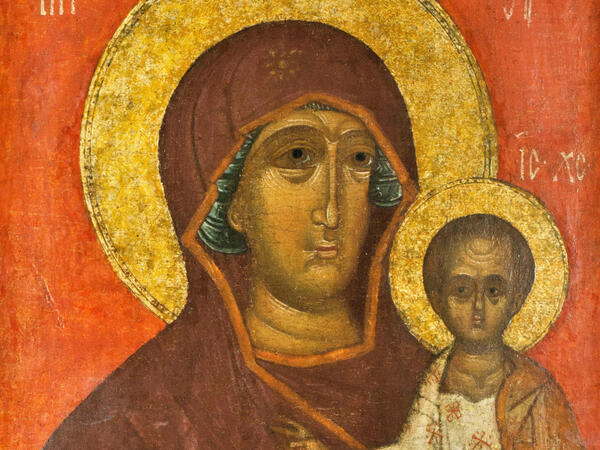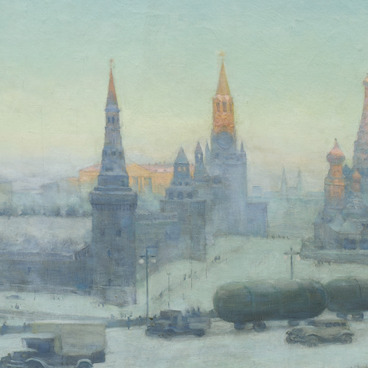Hodegetria, translated from the Greek as ‘She who shows the way’, is one of the oldest iconographic types in Byzantine art. The name ‘Hodegetria’ comes from the name of the Hodegon monastery in Constantinople, where the miracle-working icon was kept. Legend has it that the icon was painted by Luke the Evangelist when the Mother of God was still alive.
One of the versions of the Constantinople Hodegetria was brought to Russia in the 11th century. In 1046, the Byzantine emperor Constantine IX Monomachos used the Hodegetria icon to bless his daughter Anna, who was to marry the Chernigov prince Vsevolod, the son of Yaroslav the Wise. After the death of Vsevolod Yaroslavich, his son Vladimir Monomakh inherited the holy icon and transferred the relic to the Dormition Cathedral in Smolensk. Thus this canonical version of the Hodegetria iconographic type was called ‘Smolenskaya’. The icon was the main holy relic of Smolensk; it was believed to have saved the town from the Tatar-Mongol yoke in 1239. In the 14th century, the icon was brought to Moscow and installed in the Annunciation Cathedral in Kremlin. The Smolensk icon of the Mother of God was particularly revered in Rus’. The original image has not survived.
In this iconographic type, the Mother of God and the Christ Child are depicted almost frontally, they face the praying worshipper and their heads do not touch. The Divine Infant is seated in the arms of the Mother. He blesses with his right hand, in his left hand he holds a scroll symbolizing the Gospel. With her right hand, the Mother of God points to the Christ Child as the Savior.
The icon from the Irkutsk Regional Art Museum was painted in the northern Novgorod lands. The image is characterized by the painting techniques typical of the “red-background” icons: white inscriptions against the red background, yellow-colored margins, gold color being used only to depict the halos. The edge of the halos is marked by a dotted pattern imitating a pearl decoration. The icon is distinguished by a special rendering of forms, which makes them look hard, by the clarity of the rhythm and bright open colors: light green, red, and orange-brown. The image of the Mother of God is stern and sublime, emotionally reserved and tense. The laconic and expressive language of the icon embodies the ideal of Novgorod icon painting.
One of the versions of the Constantinople Hodegetria was brought to Russia in the 11th century. In 1046, the Byzantine emperor Constantine IX Monomachos used the Hodegetria icon to bless his daughter Anna, who was to marry the Chernigov prince Vsevolod, the son of Yaroslav the Wise. After the death of Vsevolod Yaroslavich, his son Vladimir Monomakh inherited the holy icon and transferred the relic to the Dormition Cathedral in Smolensk. Thus this canonical version of the Hodegetria iconographic type was called ‘Smolenskaya’. The icon was the main holy relic of Smolensk; it was believed to have saved the town from the Tatar-Mongol yoke in 1239. In the 14th century, the icon was brought to Moscow and installed in the Annunciation Cathedral in Kremlin. The Smolensk icon of the Mother of God was particularly revered in Rus’. The original image has not survived.
In this iconographic type, the Mother of God and the Christ Child are depicted almost frontally, they face the praying worshipper and their heads do not touch. The Divine Infant is seated in the arms of the Mother. He blesses with his right hand, in his left hand he holds a scroll symbolizing the Gospel. With her right hand, the Mother of God points to the Christ Child as the Savior.
The icon from the Irkutsk Regional Art Museum was painted in the northern Novgorod lands. The image is characterized by the painting techniques typical of the “red-background” icons: white inscriptions against the red background, yellow-colored margins, gold color being used only to depict the halos. The edge of the halos is marked by a dotted pattern imitating a pearl decoration. The icon is distinguished by a special rendering of forms, which makes them look hard, by the clarity of the rhythm and bright open colors: light green, red, and orange-brown. The image of the Mother of God is stern and sublime, emotionally reserved and tense. The laconic and expressive language of the icon embodies the ideal of Novgorod icon painting.



